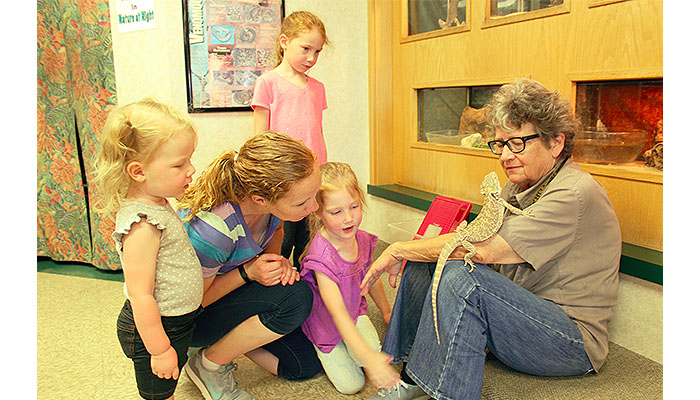
By CRISTINA JANNEY
Hays Post
The Sternberg Museum’s Discovery Room was abuzz on Friday with children ooh-ing and aww-ing.
Some cautiously approached Alicia Gaede, naturalist, and stroked African Savannah water monitor Kwaai’s head. Once Alicia or one of the children stroked just the right spot at his ears, Kwaai closed his eyes and flicked his tongue in apparent pleasure.
His name, Kwaai, means fierce, but he is very gentle for his carnivorous species. He eats insects and mice and even once popcorn chicken. He regularly dons a harness and accompanies Gaede on walks around the museum. He has also become a popular museum ambassador, participating in birthday parties and other public events.
 “When people meet him, they can’t believe he acts so much like a dog,” she said. “He is our scaly puppy, and we have one downstairs that is our scaly cat. The one downstairs wants to be carried everywhere. If you make him angry, he will poop on you.”
“When people meet him, they can’t believe he acts so much like a dog,” she said. “He is our scaly puppy, and we have one downstairs that is our scaly cat. The one downstairs wants to be carried everywhere. If you make him angry, he will poop on you.”
Kwaai was someone’s pet. The owner could no longer take care of him, so Kwaai came to live at the Sternberg two years ago.
“He was here for a while, and we were just trying to make him healthy again,” Gaede said. “When I got this job here, I decided to make him able to be handled. It was really a fast turnaround, maybe two weeks when he was looking for people to be touched.
“He was interested to go for walks. He likes to take baths and curl up in a towel. He will sleep with you for hours curled up in a towel. It is like I am walking around with this really weird baby.”
Kwaai was accompanied Friday by Toothless, one of the museum’s chuckwallas.
 Chuckwallas are native to the Arizona desert. Much smaller than the Savanah water monitor, Toothless easily fit in handler and volunteer Malachi Chance’s hand. Chance, 11, has been volunteering at the museum for seven years.
Chuckwallas are native to the Arizona desert. Much smaller than the Savanah water monitor, Toothless easily fit in handler and volunteer Malachi Chance’s hand. Chance, 11, has been volunteering at the museum for seven years.
Chance ran into a little problem when Toothless climbed up his shoulder and into his hair, but Chance was able to extract him with hurting himself or the chuckwalla.
While humans secrete salt when they sweat, chuckwallas spit it out of their noses. Toothless’ roommate is Hiccup. Gaede said Hiccup is a little larger and may be a female. The chuckwallas will soon be getting three new roommates — Sonoran desert toads that recently came to the museum after being illegally trafficked.
The toads’ natural habitat is also the Arizona desert.
Thea Haugen, retired Sternberg naturalist, was showing off bearded dragon, Yoshi.
The dragon belongs to one of the museum staff members and is a frequent guest at museum programs.
Bearded dragons eat both vegetables and insects like crickets.

The reptiles’ visit was a part of the Meet the Animals program at the Sternberg. The program started in June is supposed to run through the end of July from 11 a.m. to noon each Friday. However, Gaede said the program has been so popular she might extend it into August, at least until school starts.
“A lot of kids are afraid of reptiles or amphibians,” she said. “It is different than seeing them behind glass. They are not moving a lot, and a lot of people think our animals are fake. So being able to meet them like this shows them that they are not quite as scary. … People are taught to be afraid of these things.
“I love that we can not only teach them about species, but about our animals individually, because reptiles, personally I believe, they can have personalities.”
People see a snake and they automatically think it is venomous, Gaede said. However, only a small portion of the snakes in Kansas are venomous.
The program is free with admission. New animals will be featured each Friday.
Keep up with what’s happening at the museum on the Sternberg’s Facebook page or visit its website at http://sternberg.fhsu.edu/.
